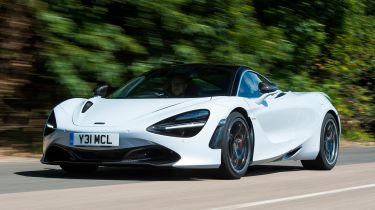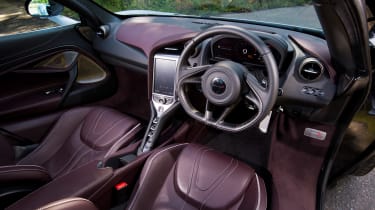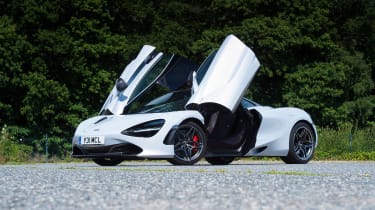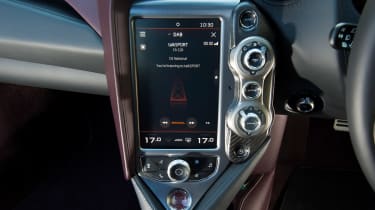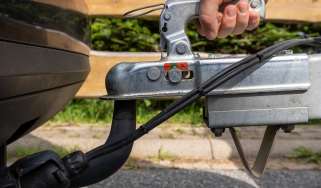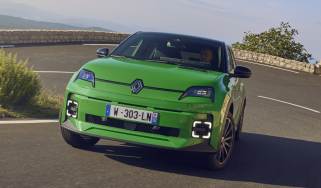McLaren 720S (2017-2023) review
The McLaren 720S takes on the Ferrari 488 – with more power, greater performance and a dash of practicality

The core model in McLaren’s Super Series is known as the 720S; that number (720PS, or 710bhp) a reference to the enormous power output of its mid-mounted 4.0-litre twin turbo V8. It was produced as the successor to the McLaren 650S and is brutally fast by any measure - reportedly barely slower than the iconic McLaren P1 around a twisty circuit.
Rivals for the McLaren 720S include the Ferrari 488 GTB and Lamborghini Huracan Evo, although cars at this level become playthings from the buyers’ point of view. So you might equally be weighing-up a McLaren against a new boat, or even a plane.
• Best supercars on sale right now
The 720S sits in McLaren's Super Series line-up alongside a convertible Spider version and the 765LT model. These are positioned above a six-car Sports Series line-up comprising the 600LT, 600LT Spider, 570S, 570GT and 570S Spider, as well as the 540C entry model.
Although very similar in format to its predecessor, McLaren maintains around 95% of the 720S parts are newly developed. The styling is certainly more extreme – designers claim to have taken inspiration from the Great White Shark – and the car is built around a new MonoCage II structure that combines a roof and body-tub in a one-piece carbon fibre unit. The previous car’s MonoCell was a carbon tub to which an aluminium roof was attached, so the new version is stiffer.
More reviews
Aside from the obvious styling changes, other significant updates for the 720s over its predecessor include bigger openings for the dihedral doors for easier access, and a new cabin design with upgraded TFT dash and new infotainment system.
Buyers have a huge amount of choice when it comes to the spec of their 720S, with standard, Luxury and Performance packages that imbue the supercar with varying level of plushness or sportiness. Those wanting to make their mark can have their 720S personalised via McLaren’s bespoke MSO service.
The McLaren 720S is spectacular to look at and stunning to drive, with performance potential that’s not far removed from the firm’s P1 hypercar. The 720S definitely offers more visual drama than the previous 650S, and takes McLaren Automotive forward in leaps and bounds in other areas too. The expensive, bespoke feel of the interior, as well as the infotainment tech, is much improved. Phenomenal performance is a given, but the superlative ride quality and relaxing nature of the car when cruising, plus a dash of genuine practicality, mean it has ‘daily driver’ credentials too.
Engines, performance and drive
The McLaren Super Series designation means this is a car designed to offer enthusiastic drivers an extreme level of road car performance, and as such its ride is more taut than models in the Sports Series. Still, the superlative set-up of the firm’s actively interconnected hydraulic damping system means that in Normal mode the car soaks up bumps with more finesse than many ‘mere’ GT cars.
There’s a driving mode system called Proactive Chassis Control II, and switching to Sport or Track settings allows you to add extra stiffness to the damping and roll response, albeit at some cost to the ride quality. However, even when in Track mode, the damping offers a level of finesse that is – relatively speaking – quite outstanding, simultaneously allowing the driver to extract phenomenal grip from the sticky rubber tyres.
The steering, which is electro-hydraulically powered, provides delightfully detailed feedback through the rim of the wheel, giving drivers a thrilling sense of connection with the tarmac as the car carves incisively through corners. Working beautifully together, the chassis and steering allow you to cover ground at phenomenal speeds, quite inappropriate to road use.
Even on the track, you’d need a fair amount of skill and confidence to use anything like the car’s full potential. Make no mistake, though, the 720S will make even an average driver feel very fast indeed. There’s even a Variable Drift Control system to let you hang the tail out and look the hero while still using the safety blanket of ESC.
The other side of the 720S experience is the incredible docility the car displays when you’ve eased off and want to cruise. Then the superb ride comfort comes into its own, and the lack of vocal histrionics from the engine, and silky smooth auto gear shifts mean you can loaf along on the motorway feeling totally relaxed.
Engines
The 4.0-litre engine situated behind the seats is a reworked version of the company’s familiar V8. It’s twin-scroll turbos are designed to minimise lag, but there’s still a moment when they’re spooling-up from rest that makes you aware you’re being forced to wait for the real action. And to some extent you are, but you’ve barely time to recognise the fact before boost builds and you’re on a rocket-ship ride that races you to 62mph in a shocking 2.9 seconds.
It will keep going to a 212mph top speed if you let it, and while that initial launch phase means it doesn’t feel quite as linear as the Ferrari 488 GTB, it’s a pretty meaningless difference in performance terms. Of course it’s only when you come to rest that the turbos wind down, so there’s no sense that lag could ever impede progress across country. Only your sense of self-preservation can do that, because the 720S develops far more power than you can safely use on the road.
The engine note isn’t as characterful as some rivals, but it’s pleasingly quiet when cruising. When you’re trying a bit harder, the V8 roars with an engaging accompaniment of chatters and whooshes from the turbochargers. It’s no Lamborghini V12, but many drivers might prefer its quieter nature.
MPG, CO2 and Running Costs
There’s no question a McLaren 720S is going to be fiendishly expensive to run, at least from the perspective of an average UK income. However, there are plenty of folk around who’ll see the cost as simply par for the course, and to be fair the McLaren is not likely to hit you harder in the wallet than its key rivals.
The expenditure starts with the purchase cost, and while the £200,000-plus starting price is significant enough you can bump it up quickly by adding bespoke colour and trim options.
As it'll be hard to resist exploiting at least some of the car's dynamic potential, real-world fuel consumption is likely to be in the mid-teens.
Annual road tax will cost £475 per year in years two to five of ownership thanks to the 720S’ hefty list price, but the really high costs are going to centre on servicing. Replacement of consumables like tyres and brakes will prove expensive, as will any unscheduled maintenance that’s not covered by the warranty.
Insurance groups
Insurance for the McLaren 720S isn’t going to come cheap either, as the car falls into the top 50 group rating.
Depreciation
If you buy a 720S outright you’ll lose a lot of money at resale time, as unfortunately no luxury car is immune to the ravages of depreciation – unless it’s a particular rarity like the McLaren P1 of course. McLaren still reckons its residual values are higher than rivals, and that’s reflected in the relatively attractive lease deals the company offers.
Interior, design and technology
There’s a clear family resemblance, but the 720S is markedly more flamboyant in style than car it replaced. That’s in part a response to feedback from some quarters that owners want more reasons to be noticed when spending over £200,000 on a supercar.
The new body – now made of aluminium and carbon fibre – features an unmistakable new teardrop-shaped cabin profile, with slender rear pillars made possible by the rigid MonoCage II structure. The new car’s nose is swoopier, with the LED driving lights now a straight line instead of the 650S’s ‘McLaren swoosh’, and the old car’s side air-intakes have disappeared too. Or at least they’ve disappeared from sight, as clever design means airflow is now channelled to the engine via ducting built into the doors.
Speaking of the doors, they’ve been modified too, with cut-outs in the roof allowing you to step over the sill and down into the car, rather than having to duck under the roof panel. The sill is lower with MonoCage II also, and collectively the changes mean the 720S is easier to get into.
Once inside, you’ll find an interior dominated by a central binnacle-style instrument pod, that has an unusual – some might say gimmicky – trick up its sleeve. The whole instrument pack tips forward for track use, so you only get to see the edge of the dials, with only essential info like revs, gear and speed provided. McLaren says this aids driver focus, and improves driver sightlines across the bonnet.
As for the interior ambience, it’s safe to say the 720S has lifted McLaren up a notch. The doors and seats are beautifully trimmed in soft, tactile leather, and switchgear has a bespoke machined finish that feels suitably opulent and exclusive.
Sat-nav, stereo and infotainment
When McLaren Automotive first launched its road car line-up, the firm’s in-house IRIS infotainment system looked novel, but in reality was awkward, impractical and under-developed. You wouldn’t say the same of the latest system in the 720S, which has been developed with help from an outside third party. You still get a big portrait-orientated central touchscreen, but it’s now pleasant to use and decently intuitive. It’s still some way off being as slick as a mass-produced rival system like BMW’s iDrive.
As well as sat-nav, phone connectivity and a high quality audio set-up, you also get to play with a track telemetry system that lets you download your data.
Practicality, comfort and boot space
The McLaren 720S is designed for driving thrills, not trips to the DIY shop, so as such you wouldn’t expect it to offer much in the way of load space.
However, the 720S is so easy to drive and so comfortable that it’s hard to think of a supercar better suited to daily driving. It’s especially notable for its terrific all-round vision. Supercar drivers used to claustrophobic rear cabin pillars, or confining bulkheads, will look around the airy cabin of the McLaren – and the exterior views afforded to the sides and rear of the car – with some amazement.
Space for phones and oddments is limited, but you can find room for them in the centre console. And while the boot spaces (front and rear) are relatively limited, there’s a big parcel shelf behind the seats that you can use to strap down extra luggage.
Size
The McLaren 720S is pretty compact by supercar standards, measuring 4,544mm nose-to-tail which is barely longer than a Porsche 911. It’s noticeably wider than the Porsche at 2,161mm, but the McLaren takes up less space on the road than a Ferrari 488 GTB.
Leg room, head room & passenger space
The McLaren two-seater provides comfortable interior space for all but the tallest occupants, who will find the accommodation acceptable but not exceptional. Everyone else should find their perfect driving position with ease, thanks partly to the wide range of adjustment of the steering wheel. When it comes to seat choices, make sure you try before you buy; the Sports seats have fixed backrests, which are rather upright, and while they grip you tightly you’ll be able to jump in and out more easily with the standard items.
Boot
The McLaren has two boot areas. The one at the front will swallow 150 litres of luggage, and another at the back that will take a total of 210 litres. Pack wisely with soft bags, and it’s surprising how much you can cram in. Don’t expect to be able to carry anything bulky, though.
Reliability and Safety
When it comes to safety, the incredible performance, handling and braking capacity of the McLaren 720S mean it’s easy to avoid trouble. But conversely, if you do find it, you may be travelling very fast indeed.
With top-notch engineering and a motorsport background to call on, you can expect the McLaren’s MonoCage II core structure to be immensely strong in the event of an impact. Euro NCAP will not perform an independent crash test on the 720S, but the lack of ‘active’ safety aids like autonomous braking, lane-keep assistance and blind spot monitoring wouldn’t help the car achieve a high score anyway. You do get a reversing camera and parking sensors, but that’s about it.
Our mixed experiences with McLaren electrics are worth considering; the evolutionary nature of much of the tech in the 720S will mean potential problems should have been ironed out, however. The build quality is superb too, and McLaren’s seemingly relentless attention to detail in all aspects of its operation can only be reassuring.
Warranty
There’s a standard three-year, unlimited mileage warranty across the entire McLaren line up. You can extend cover to cars up to 12 years old, too.
Servicing
The 720S requires a service annually or every 9,000 miles, which includes a software update.
